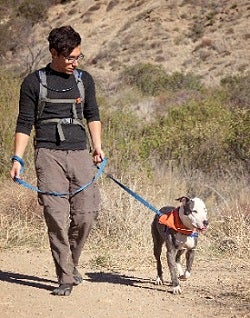
Got behavior-challenged dogs?
Our town hall experts are here to share even more tips to get them adopted!
In mid-November, Caitlin Quinn, director of operations at HeARTs Speak and Tori Fugate, chief communications officer for KC Pet Project joined us for the town hall Successfully Marketing and Adopting Hard-to-Place Pets. It proved to be so popular that Caitlin and Tori couldn’t get to all the questions that came up during the event!
Well, they couldn’t until now – what follows are their answers to most (if not all) of the questions they didn’t have time to get to. Because some of the questions were quite similar, we’ve combined them to get an inclusive answer that we hope will be helpful for everyone.
How honest is TOO honest? Should we be upfront about limitations like “no cats or kids” in bios or leave it to the adoption counselor to share those details?
 Personally, we leave such statements for a conversation or adoption appointment, and make sure we deliver any additional info in a fun, positive way. For example, you can say, “Fiona has requested not to share her home with other pets, but she’s so incredible you’ll quickly realize she fills your heart!” You can find some other language options here.
Personally, we leave such statements for a conversation or adoption appointment, and make sure we deliver any additional info in a fun, positive way. For example, you can say, “Fiona has requested not to share her home with other pets, but she’s so incredible you’ll quickly realize she fills your heart!” You can find some other language options here.
Use marketing efforts as opportunities to show off your dogs as they are today, not to put the focus on their challenges. Talk about how they have come such a long way in your care and would be able to continue progressing in a foster or adoptive home. Use video clips or livestreamed adoption showcases to display your dogs’ personalities and show them connecting with people.
Good photos are important, too. Consider working with a photographer on a special photoshoot for your dogs and use a bio writing template to give their description a refresh. If you use volunteers for your photos, some of our favorite tips to help fosters and volunteers get good photos are in this blog and this webinar!
Can you talk a bit more about how to talk about dogs with dramatic back stories?
If an animal may have come from a known cruelty or medical case, note the situation briefly but save the full story for an adoption counseling situation. These bio writing templates show how to acknowledge a background story while focusing primarily on who the animal is today.
Too often, we over-dramatize their stories because we think adopters will be moved by a sad tale. Be honest and only share what you know. Here is an example of a post where we didn’t have all the info.
How can I be truly open to adopters instead of automatically vetting them based on the kinds of questions they ask?
It’s always hard to overcome our own biases, but people are often more capable and adaptable than we give them credit for. Sometimes we idealize the home we’d like an animal to have when there are perfectly acceptable alternatives.
Ask questions in new ways where you can’t anticipate the “correct” answers. These might be, “What would an average day with your dog would look like? Tell me what you loved about your past pets? What were some of their quirks?”
We all can make room in our brains and processes for learning to manage our biases, and there are amazing resources that can help:
Roadblock Free is the Way to Be
What are some strategies for kennel-reactive dogs or those with behavioral issues within the shelter but better behavior outside of our facility?
In the shelter use signs like, “I’m stressed out in my kennel, but ask to meet me and I’m bound to steal your heart.” Let potential adopters meet those dogs someplace outside of the kennel environment.
For online marketing, video is your best friend. Show these animals outside of the stressful environment or after they’ve gotten through that reactive moment. Interview volunteers or get testimonials from those that love them and get creative about showing their personalities. Give the adoption staff access to the video and ask them to show it to potential matches before they see the reactive behavior.
You talked about your Dog Day Out program; are dogs with behavior issues able to participate in that?
 KC Pet Project often has people take dogs with some behavior concerns in our shelter on an outing because an animal’s personality starts to shine, and their behavior issues begin to diminish once they spend a few hours out of the kennel.
KC Pet Project often has people take dogs with some behavior concerns in our shelter on an outing because an animal’s personality starts to shine, and their behavior issues begin to diminish once they spend a few hours out of the kennel.
We use a sign-up form online and we have them sign a contract with a few stipulations (they’ll return them by the designated time, they won’t go to dog parks or have them interact with other animals, etc.).
When a dog goes on a Dog Day Out, we have our volunteers fill out a feedback form to tell us how the day went. The information we get from these experiences helps us market the dogs for foster homes and adopters.
How can I get my operations and adoption staff on board with new marketing approaches to placing dogs with issues?
Marketing never exists in a vacuum; it is deeply related to operations and adoption policy. The role of marketing is to help define our programs for the community, communicate how to use our services, and advertise how people can get involved. But great marketing alone can’t increase adoptions or build more positive relationships with the community if the experience of adopting is still laden with barriers and hurdles to approval. This webinar talks more about how positive marketing and adoption policies must work together.
And don’t forget to get your staff on board with not using “industry” language with the public. It’s a tough habit to break, but many staff start to have “aha!” moments around using jargon when confronted with this idea: Before you did this work, did you know what TNR or RTO were? Or panleukopenia? Or reactivity?
Asking them to make a short list of every word that was confusing to them when they first started this work can kick start a conversation. Those lists or brainstorms similarly help you build an internal document of terms to flag and replace with more straightforward language.
How can we create successful videos?
Video is a very powerful tool that you should incorporate into your marketing. A few tips:
- Raw footage is totally fine! You came do minor edits in TikTok, Instagram, and even Facebook (to a degree) to make it more engaging.
- The attention span for video is relatively brief. Keep video of any kind short and steady (nothing too shaky!).
- On the other hand, long stories are good content for a live session. Be ruthless about editing, though, and only include what is critical to the factual and emotional stories.
- Between 65% and 85% of viewers watch videos without the sound on, so use captions and keep the content more visually focused rather than relying on audio cues.
- Don’t be afraid to experiment with the time of day you’re posting so you can capture varied audiences!
How can very small shelters in rural areas expand their reach?
This is a great opportunity to step back into traditional marketing. Building relationships with local radio or any media publications, and even local businesses is a nice way to reach new people. Skip the press release and send an introductory email to local media contacts; include a brief story pitch. Think about what unique stories you have to tell. How can telling the story of one animal or program help you get more interest overall?
If you enjoyed this program spotlight, you can find our complete catalog of spotlights here.